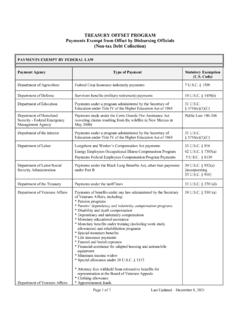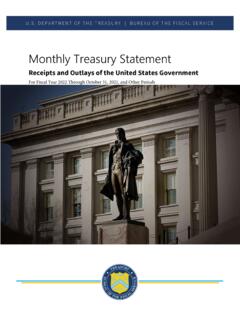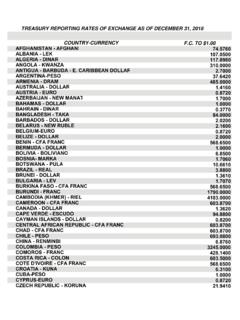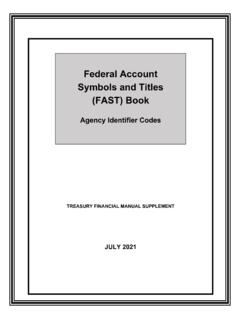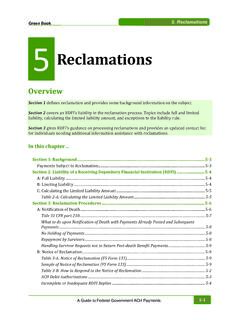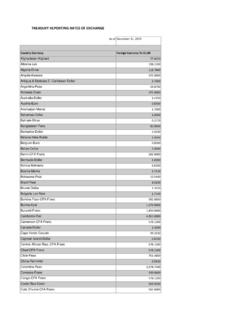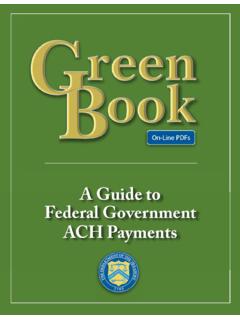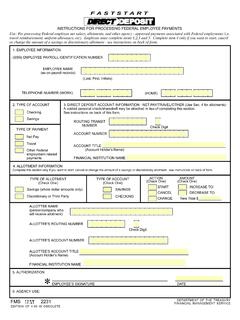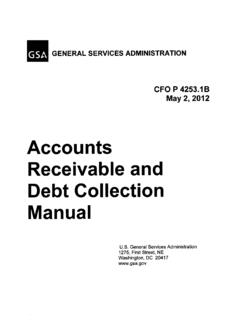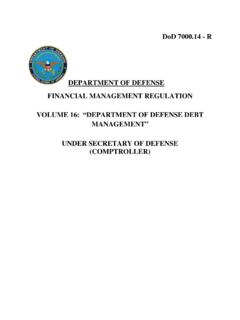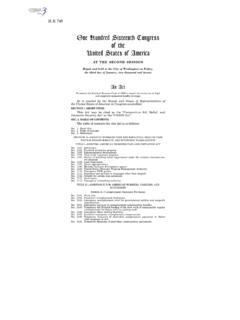Transcription of Chapter 6 Delinquent Debt Collection
1 Chapter 6 Delinquent debt Collection 6-1 Overview Agencies should have fair but aggressive programs to recover Delinquent debt , including defaulted guaranteed loans acquired by the Federal Government. Each program should include a debt Collection strategy, consistent with governmentwide and agency requirements, to restore the Delinquent debts to current status or, if unsuccessful, maximize Collection on the agency's accounts. The strategy should further promote the resolution of delinquencies as quickly as possible, since the ability of an agency to collect its Delinquent debts will generally decrease as the debts become older. The strategy should take into account that debts within the jurisdiction of the bankruptcy courts are subject to the provisions of the United States Bankruptcy Code (see page 6-57).
2 When a debtor has filed for bankruptcy protection, legal counsel should be consulted prior to continuing any Collection activities, including those described in this Chapter . This Chapter describes the Collection techniques and tools available to assist agencies in collecting Delinquent debts, and supplements the debt Collection requirements contained in statutes and regulations. In this Chapter , a Federal agency that is owed a debt is sometimes referred to as a creditor agency. Revised March 2015 Delinquent debt Collection 6-2 debt Collection Rules and Guidance Hierarchy This Chapter is divided into three parts: Part I, Managing Delinquencies, provides information on debt Collection strategies and principles; Part II, debt Collection Tools and Programs, discusses Delinquent debt Collection tools, such as cross-servicing (transfer of debts to Bureau of the Fiscal Service (Fiscal Service) for Collection ), offset, administrative wage garnishment, collateral liquidation, and litigation; and Part III, Miscellaneous Topics, describes several techniques an agency uses to support the debt Collection process.
3 Revised March 2015 Delinquent debt Collection 6-3 This Chapter applies to debts owed to the United States, including loans, fines, penalties, overpayments, and fees, but does not apply to the Collection of Federal tax debts, debts owed by Federal agencies, or debts owed by foreign countries. Debts based in whole or in part on conduct in violation of the antitrust laws or involving fraud, the presentation of a false claim, or misrepresentation on the part of the debtor or any party having an interest in the claim must be referred to the Department of Justice (DOJ) for action. At its discretion, DOJ may return the debt to the agency for handling in accordance with the procedures described in this Chapter . The policies and procedures detailed in this Chapter do not create any right or benefit, substantive or procedural, enforceable at law or in equity by a party against the United States, its agencies, its officers, or any other person.
4 The failure of an agency to comply with any of the provisions in this Chapter shall not be available to any debtor as a defense, except as otherwise allowed by law. Revised March 2015 Delinquent debt Collection 6-4 Part I Managing Delinquencies Background Delinquency Defined. A debt becomes Delinquent when: payment is not made by the due date or the end of the grace period as established in a loan or repaymentagreement, in the case of a debt being paid in date of delinquency is the payment due : Borrower s loan payment is due January 1. The loan agreement allows a grace period of 15 days, meaning that the lending agency will not assess late charges or declare the loan Delinquent if the payment due on January 1 is made before January 16.
5 If Borrower makes his or her payment before January 16, the loan is not Delinquent . However, if Borrower fails to make a payment by January 16, then the loan is Delinquent and the date of delinquency is January 1 (the payment due date). payment is not made by the due date specified in the initialbilling notice, in the case of administrative debts such asfines, fees, penalties, and overpayments. The due date isusually 30 days after the agency mailed the notice. The dateof delinquency is the date the agency mailed or delivered thebilling : Agency discovers that duplicate payments were made to beneficiary and seeks to recover the overpayment. On March 1, the Agency mails a notice to beneficiary informing him about the overpayment.
6 The notice states that payment must be made by March 31 to avoid assessment of late charges and enforced Collection action. If beneficiary pays the amount requested before March 31, the debt is not Delinquent . However, if beneficiary fails to pay by March 31, then the debt is Delinquent , and the date of delinquency is March 1 (the date of the initial notice about the debt ). Revised March 2015 Delinquent debt Collection 6-5 debt Collection improvement Act of 1996. T h e debt Collection improvement Act of 1996 (DCIA) provided Federal agencies with a variety of Delinquent debt Collection tools. The DCIA: centralized Delinquent debt Collection at the Department of the Treasury (Treasury), requiring Treasury to pursue Delinquent debts that are not actively being collected by Federal creditor agencies, a program known as cross- servicing ; established a centralized offset process at Treasury, known as the Treasury Offset Program ; authorized Treasury to manage a governmentwide, performance-based private Collection agency contract for referral of Delinquent debts for Collection ; requires Federal agencies to report Delinquent consumer debtsto credit bureaus; permits Federal agencies to administratively garnish the wagesof non-Federal employees.
7 And requires credit-granting agencies to bar debtors fromreceiving Federal direct, guaranteed, or insured loans untiltheir Delinquent debts owed to the United States Collection Statutes. A list of the Federal statutes applicable to governmentwide debt Collection is found at Appendix 4. Governmentwide debt Collection Regulations. The following regulations apply to governmentwide debt Collection : The Federal Claims Collection Standards (FCCS) are thegovernmentwide debt Collection standards published jointlyby Treasury and DOJ in Title 31 of the Code of FederalRegulations (CFR), Parts 900 through 904 (31 CFR Parts900 904); The debt Collection regulations issued by Treasury s FiscalService at 31 CFR Part 285 govern Treasury s cross-servicing procedures; Treasury s centralized offset program,including administrative, tax refund, and salary offsetprograms; administrative wage garnishment; and, theRevised March 2015 Delinquent debt Collection 6-6 barring of Delinquent debtors from receiving Federal loans and loan guaranties.
8 And Salary offset regulations published by the Office ofPersonnel Management at 5 CFR Part 550. The Office of Management and Budget (OMB) has issuedOMB Circular No. A-129, Policies for Federal CreditPrograms and Non-Tax Receivables. The Treasury Financial Manual Chapter I TFM 4-4000, "DebtManagement Services Collection of Delinquent Nontax debt ."Governmentwide debt Collection Guidance. Fiscal Service has issued this document and other debt Collection guidance, such as the Guide to the Federal Credit Bureau Program a nd the Treatise on Federal Nontax debt Collection Law. debt Collection statutes, regulations, and guidance are found at the Fiscal Service website at Agency and program-specific statutes, regulations, and policies are not covered in this Chapter , but they also govern the debt Collection programs of a specific agency.
9 Agency personnel should contact agency counsel for information about agency-specific laws and requirements. Key debt Collection Principles Federal agency personnel who collect debts for the government should understand the following key principles: Agency Regulations. Regulations are rules and procedures governing an agency s programs or administrative processes. In many cases, an agency is required to publish rules and procedures in the Federal Register. After publication in the Federal Register, regulations are codified in the Code of Federal Regulations (CFR). Federal Register and CFR documents may be accessed online at governmentwide regulations mentioned above (Part I, Background) provide general rules and standards for a Federal agency to follow when using various debt Revised March 2015 Delinquent debt Collection 6-7 Collection tools.
10 Each agency must promulgate its o wn debt Collection regulations. An agency should adopt the governmentwide debt Collection rules and standards for its own programs, when appropriate. Additionally, an agency s rules and standards should cover any additional debt Collection tools the agency intends to use. Agency counsel should be consulted to determine when an agency s rules and procedures must be published in the Federal Register. Program Goals and debt Collection . Delinquent debts arise from various Federal Government programs and actions. For some types of debts, the government s interests may be best served by resolving debts in a way that achieves an important goal of a specific program. For example, it may be in the government s best interest to lower a debtor s monthly payments to allow a debtor to remain in his or her own home, keep a business, or to recover from a disaster.
